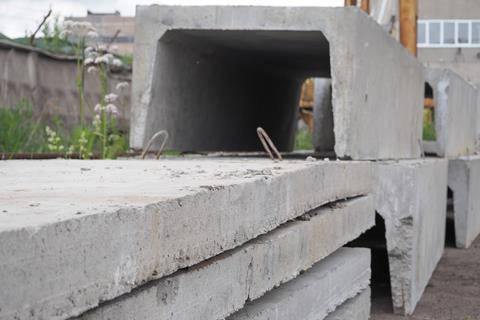Bricklike nanostructure allows calcium silicate hydrate to flex without breaking

A key ingredient of cement can be made more elastic and crack-resistant by giving it a structure that mimics the nanoarchitecture of sea urchin spines.
Calcium silicate hydrate (CSH) gives concrete its compressive strength, making it the most used human-made construction material in the world. But being brittle, it lacks flexural strength and so weakens and fractures if anything causes it to bend. Steel bars are usually used to improve concrete’s flexibility but these are expensive and prone to corrosion. Scientists have sought nanoscale solutions before by inserting soft matter into CSH to get a more elastic material, but the final nanostructures have remained irregular, limiting its flexing potential.
Now, Helmut Cölfen at the University of Konstanz, Germany, and his colleagues have made CSH with a highly ordered nanostructure based on their previous work into the structure of sea urchin spines. ‘Nature uses extremely sophisticated building principles to build up biominerals, which show outstanding properties,’ says Cölfen.
Sea urchin spines are made from hard but brittle calcite – essentially chalk – that is normally broken easily. But the calcite in sea urchins is super strong because it is mesocrystalline; that is, it is regularly ordered like rows of bricks, while thin amorphous layers in between them function as pliable mortar that stop cracks developing.
Inspired by this arranement, the team made a colloid suspension of CSH particles by adding calcium chloride to a sodium silicate solution in the presence of a polyacrylic acid co-polymer. Normally, CSH particles want to clump together randomly but the polymer prevented this and ensured even dispersal. They then developed two methods to control and trigger the CSH particles to self-assemble into mesocrystals: one required adjusting the pH and the other involved altering the polymer to CSH ratio of the colloid.
Imaging the mesocrystals revealed CSH platelets in brick-like alignment while the polymer acted like a binding mortar. To test the material’s elasticity, the team pressed a 3µm square of mesocrystal with a micromanipulator under an electron microscope, revealing a flexural strength of almost 200 Megapascals, which isn’t far off steel’s flexural strength of 250MPa.
‘These results represent a remarkable step in the field and an elegant use of nature as a source of inspiration for producing new materials with unconventional properties,’ comments Filipe Natalio, who investigates bioinspired materials at the Weizmann Institute of Science, Israel. ‘Cement has been around for approximately 2000 years and since its implementation by the Romans very little has changed. Flexible cement per se is novel, and very exciting.’
Cölfen hopes that if production could be scaled up, the CSH could be used to make superior building materials. ‘In regions with earthquakes, this material could be very beneficial since it shows elastic deformation. This means a construction would shake but not break.’
He acknowledges, however, that commercialisation is a long way off. The method produces only small yields due to a fast-drying step, while the required polymers make the material are costly. He suggests that research into upscaling that avoids fast drying, as well as approaches that use cheaper polymer alternatives or less polymer, may offer solutions.
References
A Picker et al, Sci. Adv., 2017, DOI: 10.1126/sciadv.1701216












No comments yet